Table of Contents
Book Formatting
Book Formatting. In literature, there is an unsung hero, a silent influencer that significantly impacts our reading experience – book formatting. It’s a bit like the background score in a film, rarely noticed but tremendously powerful in setting the mood and pace of the story. Yes, formatting is that pivotal!
Why, you may ask? Well, imagine reading a murder mystery with comic sans font or a scholarly work in a cute, curly script. The content could be top-notch, but the wrong formatting could derail your entire experience. The power of formatting is indeed formidable, as we will discover throughout this article.
Why Do We Need Great Book Formatting?
The need for great book formatting is undeniable and multifaceted. An exquisitely formatted book not only ensures smooth reading but also subtly reinforces the theme and tone of the story. Proper formatting prevents reader fatigue, keeping the audience engaged and invested. It also establishes the writer’s professionalism, often reflecting the quality of the content. After all, if the writer has taken the effort to make the book visually appealing and reader-friendly, chances are, they’ve paid the same level of attention to their storytelling.
A striking example of formatting’s power lies in the iconic novel “House of Leaves” by Mark Z. Danielewski. With pages ranging from densely packed text to spiraling words, the formatting itself turns into an intricate labyrinth, reflecting the eerie, disorienting narrative of the book.
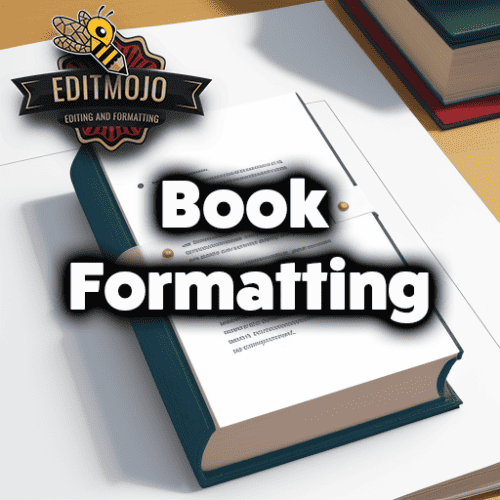
What Will This Post Cover?
This post is your ticket to understanding the depths of book formatting. We will unravel the types of formatting – from traditional print to e-books and audiobooks. We’ll dive into the crucial elements of print book formatting, such as typography, headers, footers, and page numbers, and we’ll explore the unique aspects of e-book formatting, including interactive features and responsive designs.
We’ll also touch upon the tools of the trade, guiding you through the labyrinth of formatting software. Don’t worry if it all sounds too overwhelming; we’ll also discuss when to consider hiring a professional formatter and how to avoid common pitfalls.
As the great Joan Didion once said, “We tell ourselves stories in order to live.” Formatting plays a critical role in telling those stories effectively and beautifully. So, come join us on this fascinating journey through the art of book formatting.
Understanding Book Formatting: A 360-Degree View
What is Book Formatting?
Book formatting, much like a secret code of readability, breathes life into the words penned by authors. It’s a design process that ensures a manuscript’s transition into a readable, attractive, and coherent book, whether print or digital. Every tiny detail, from the choice of font and spacing to the arrangement of chapters and paragraphs, falls under this domain. Book formatting is the unsung hero that guides a reader’s eye through the narrative labyrinth, ensuring a seamless reading experience.
Why is Book Formatting Important?
Imagine picking up a book with no paragraph breaks, no chapter divisions, and haphazard fonts. Would you be able to, or more importantly, want to continue reading? Probably not. Book formatting is your savior in the chaotic world of text, guiding you along a clear path, ensuring readability, and enticing you to turn the page. It creates a bridge between the author’s words and the reader’s comprehension, enabling a silent conversation between them. Without effective formatting, even the most eloquently written masterpiece could quickly become a cumbersome puzzle.

Different Elements of Book Formatting
From the macro level down to the micro, several elements constitute the art of book formatting. These include:
- Layout: This pertains to the general arrangement of the text and images on the page, including margins, line spacing, and paragraph indentations.
- Typography: A critical component that includes font style, size, line length, and spacing.
- Chapter and Section Breaks: These elements guide the reader through the book, serving as checkpoints in the narrative journey.
- Front and Back Matter: The often-ignored siblings of the main content, which include the title page, copyright page, dedication, acknowledgments, appendix, and more.
Each of these components has a significant role to play, and when harmonized, they create a symphony of words, unobtrusive and pleasing to the eye.
How Book Formatting Contributes to Reader Experience
Good book formatting is akin to a well-directed movie. When done right, it’s almost invisible, letting the story take the limelight. It provides a clear, consistent, and comfortable reading environment, enhancing the overall experience. Imagine the horror of reading a thriller where the climax is revealed inadvertently due to poor page breaks! In a digital context, proper formatting ensures compatibility with various e-readers and devices, making the book accessible to a broader audience.
The Evolution of Book Formatting: From Print to Digital
The journey of book formatting, much like Gutenberg’s printing press to today’s Kindle, is one of constant evolution. The transition from print to digital brought forth new considerations and challenges. With e-books, the rigidity of print formatting gave way to fluidity and adaptability, allowing the reader to customize aspects like font size and type, line spacing, and even background color. It was less about a one-size-fits-all solution and more about personalization, making each digital book a unique reading experience.
While some purists may argue that nothing can replace the charm of a well-formatted print book, the flexibility and accessibility of digital formatting are undeniable boons in the era of technology. In essence, the art of book formatting has continued to adapt and thrive, always enhancing the sacred bond between the reader and the written word.
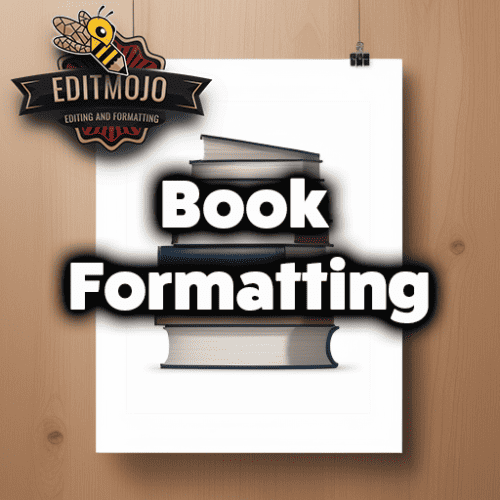
Delving Into the Art of Book Formatting
Crafting the perfect manuscript is an intricate dance, where the rhythm of words creates a symphony for the reader. Yet, an oft-overlooked component, but just as significant, is the design and structure — the formatting. The way we organize and present content has a profound impact on its reception, highlighting the importance of book formatting. Let’s delve into the details and shed light on the three primary types of book formatting: Traditional print book, e-book, and audiobook formatting.
Traditional Print Book Formatting
Old school as it may seem, traditional print book formatting remains an art form of its own. It’s a carefully calibrated composition of font selection, margins, line spacing, and page numbers. A book in its physical form, complete with its weight, texture, and even smell, provides an immersive sensory experience for the reader. Consider classics like “Pride and Prejudice” where the traditional format enriches the reading journey. The essence of its old-world charm might be lost on an e-reader or an audiobook.
E-book Formatting
Welcome to the digital era, where the written word meets technology in the form of e-books. E-book formatting is a more fluid concept, adapting to the reader’s preference on their device. With features like adjustable font size, line spacing, and screen brightness, e-books offer a level of convenience and customization that traditional print books cannot provide.
E-books require formats like EPUB or Kindle’s MOBI to ensure readability across various devices. However, such flexibility sometimes sacrifices the typographic finesse seen in print books.
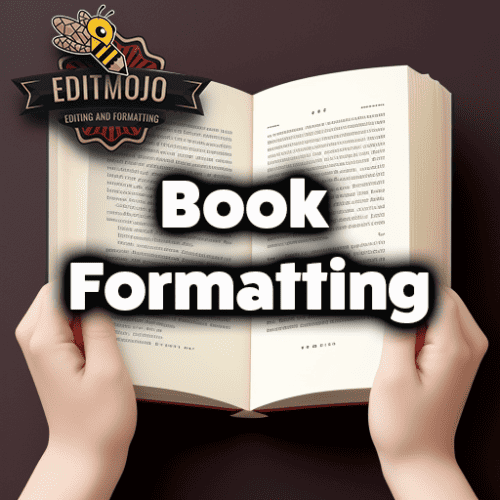
Audiobook Formatting
Imagine sitting back, closing your eyes, and listening to a tale unfold, evoking the tradition of storytelling. Audiobooks bring this experience to the modern age. The formatting focuses less on visual presentation and more on vocal narration, pacing, and sound quality. In this digital era, platforms like Audible have transformed the way stories are consumed.
Comparing and Contrasting the Three Types
These three types of book formatting cater to different reader needs and preferences. Traditional print book formatting excels in its physicality and the raw, tactile experience it provides. E-books, on the other hand, are the embodiment of flexibility and adaptability, bending to the reader’s preferences. Audiobooks, with their emphasis on auditory storytelling, provide a unique sensory experience.
It’s not a question of better or worse but rather, which format best serves the content and audience. The choice depends on factors such as convenience, lifestyle, accessibility, and personal preference.
Case Study: How Format Choice Influences a Book’s Success
The influence of format choice on a book’s success is profound. Take for instance “All the Light We Cannot See”. Initially released as a traditional print book, its immersive narrative was lauded worldwide. However, its e-book version brought it to the fingertips of readers globally, increasing accessibility. The audiobook version took it a step further, lending a voice to the characters and enhancing the emotional experience for the readers.
The popularity of the novel across all three formats demonstrates how multiple format options can expand a book’s reach and potentially, its success.
The format of a book can enhance or diminish a reader’s experience, making book formatting an essential aspect of publishing. As we continue to advance in the digital age, it’s crucial for authors and publishers to understand the strengths and limitations of each format to effectively reach and engage their audience.

Book Formatting: The Unseen Hero of Publishing and the Magic of EditMojo.com
Immersing yourself in the magical realm of a book, have you ever considered the unseen elements that enhance your reading experience? This unobserved, yet significant character in the grand tale of publishing is book formatting. It’s an intricate art that orchestrates the layout, design, and typographic details to augment the reading journey. Now, if book formatting is the hero, consider EditMojo.com as the wizard wielding the wand, effortlessly casting formatting spells to give your words the presentation they deserve.
Book Formatting: The Silent Conductor
Book formatting is the silent conductor that guides your reader through your narrative. This involves meticulous attention to elements like font style, size, line spacing, and margins. The aim? To enhance readability and ensure a seamless, engaging experience for readers. It’s like arranging a harmonious symphony where each note, i.e., each word and paragraph, contributes to a beautiful melody.
EditMojo.com: The Magic Wand of Formatting
Enter EditMojo.com, a comprehensive online tool designed to help authors and publishers transform their manuscript into a polished, professionally formatted book. This platform harnesses the power of technology and combines it with the human-like creativity needed for this intricate task.
From Manuscript to Masterpiece with EditMojo.com
To understand the charm of EditMojo, consider it as your own personal genie in the lamp. You present it with a manuscript, your wishes (requirements), and voila! Your manuscript is transformed into a beautifully formatted book, ready to captivate readers.
One of the platform’s most enchanting features is its ability to cater to different formatting types: traditional print, e-books, and even audiobooks. No matter the format you choose, EditMojo ensures your content shines.
The EditMojo.com Advantage: A Comparative Study
Comparing EditMojo.com with traditional manual formatting methods is like comparing a magic wand to a regular stick. Manual formatting can be time-consuming, arduous, and prone to human error. However, with EditMojo’s automated process, the likelihood of errors is significantly reduced.
The platform’s versatility shines through its ability to cater to different formats, maintaining the unique requirements and aesthetics of each. This flexibility would be an uphill task with manual formatting, where adapting to different formats can become a Herculean effort.
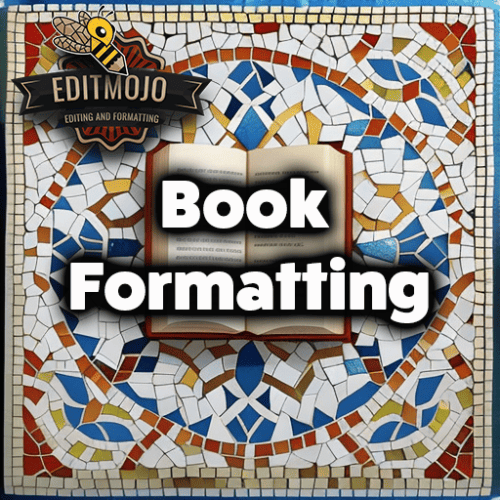
Transforming Words into Art with EditMojo.com: A Case Study
For a real-world application of the magic of EditMojo, consider the novel “Echoes of the Gidat” by Eme Savage. Initially presented as a raw manuscript, the book’s intricate plot and rich narrative were shining, but the presentation was lacking.
Upon employing EditMojo’s services, the manuscript underwent a transformation. The result? An aesthetically pleasing, reader-friendly book that did justice to Savage’s captivating narrative. The book went on to receive rave reviews, with readers particularly praising its professional formatting.
In the vast ocean of publishing, book formatting is the lighthouse guiding readers through the narrative. It’s the unsung hero that plays a pivotal role in a book’s success. And with tools like EditMojo.com, this hero gets the magical touch it deserves, transforming a simple manuscript into a captivating book.
Unveiling the Art of Book Formatting: The Essential Elements
Delve into the enthralling world of book formatting with me, as we explore the core elements that render a manuscript into a tangible masterpiece. Whether you’re an indie author dipping your toes into self-publishing or a veteran writer keen to enhance your craft, understanding the nuances of book formatting can transform your work from being just a written collection of words to a structured, easy-to-read, and visually appealing novel. Let’s unfold the elements that play pivotal roles in the domain of print book formatting.
Page Layout and Margins: Framing the Content
An often underestimated but highly crucial component of book formatting is page layout and margins. They act as the skeleton of your book, providing it with structure and coherence. An ideal margin creates a comfortable reading experience, preserving a balance between the text and white space. Think of it as framing a picture; too tight, and you risk suffocating the content, too loose, and the narrative seems adrift on an ocean of emptiness. In the words of Beatrice Warde, the ‘crystal goblet’ theory applies here; the page layout should hold the content without drawing attention to itself.
Typography and Font Choices: The Aesthetics of Words
Moving into the realm of the visual, typography and font choices bring the words to life. A font is like the costume of your words, while typography is the way they move and interact on the stage of your pages. Would you dress your thriller novel in a whimsical cursive font? Probably not. The Psychology of Fonts suggests that font choices can impact how the reader perceives the text. A well-chosen font resonates with the tone of the narrative and invites the reader to delve deeper.
Chapter Headings and Breaks: Guiding the Reader’s Journey
Just as a map guides a traveler, chapter headings and breaks guide the reader through the terrain of your story. They signal shifts in narrative, time, or viewpoint, offering a moment’s respite, and teasing the reader with a hint of what lies ahead. Used creatively, chapter headings can contribute to the story’s mood and pace and subtly reflect the progression of the narrative.
Headers, Footers, and Page Numbers: Navigating the Literary Seas
Headers, footers, and page numbers are the compass and coordinates of a book. They may seem like small details, but their absence can leave a reader feeling lost in the vast sea of text. Imagine reading “War and Peace” without page numbers; finding your place after setting the book down would be a Herculean task.
Images and Graphics Inclusion: Painting with Words and Pictures
While books are primarily a verbal medium, the inclusion of images and graphics can enrich the reading experience, especially in genres like children’s literature, graphic novels, or instructional guides. Images should augment and harmonize with the text, like a duet where both components enhance each other.
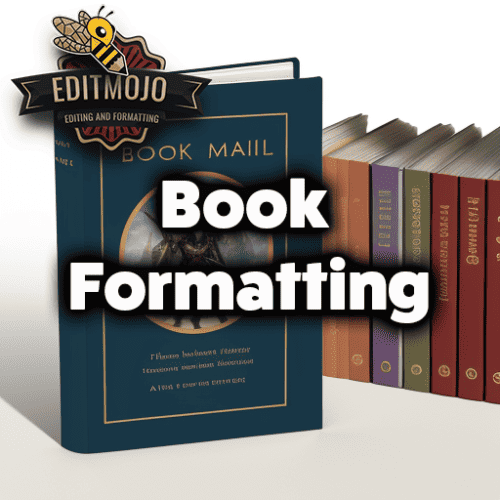
Index, Glossaries, and Appendices: The Helpful Extras
In some books, indexes, glossaries, and appendices can be the equivalent of a knowledgeable guide in a museum. They provide definitions, background information, or pointers to related topics, particularly in academic or technical texts, and are essential for the reader to fully understand the subject.
Front Matter and Back Matter: The Bookends
Finally, the front matter and back matter are the proverbial ‘bookends’ of your text. The front matter, which includes elements like the title page, copyright page, and preface, sets the stage for your book. The back matter, containing elements like the afterword, acknowledgments, and author’s bio, provides a space for reflection after the narrative has concluded. These parts frame the main content and provide relevant context.
Book formatting is akin to preparing a meal; the narrative is the main ingredient, but the presentation – the way it’s served and garnished – can elevate it from a simple dish to a gourmet experience.
Mastering E-Book Formatting
In this bustling digital age, the realm of e-books has opened up a new frontier for both writers and readers. However, crafting an e-book isn’t as straightforward as merely transposing a print manuscript onto a screen. It demands a distinct set of skills, particularly in the realm of book formatting. Below, we will delve into the nuances of e-book formatting, explore its distinctions from print books, and discover the potential that interactive features hold in enhancing the reader’s experience.
Differences Between Print and E-Book Formatting
The print and digital formats exist in different spheres, with varying rules and regulations. With print books, formatting is static, uniform, and adheres to strict physical constraints. Conversely, e-book formatting is a digital chimera, being fluid, flexible, and catering to various screen sizes and reader preferences.
E-books diverge from print books in terms of interactivity, scalability, and navigability. The interactive features inherent to e-books, which we’ll delve into later, provide an added layer of reader engagement. The digital format’s fluidity allows readers to scale font sizes, which is impossible with print. Lastly, e-books offer seamless navigation between chapters, sections, or even hyperlinks, further distinguishing them from their print counterparts.
Format Types: EPUB, MOBI, PDF, etc.
There are several dominant formats in the e-book universe, each with its pros and cons. EPUB is widely accepted as the industry standard, as it supports resizable text, embedded fonts, and images. MOBI is primarily used on Amazon Kindle devices. It’s less flexible than EPUB, but it’s still a viable option for Kindle users.
PDF stands apart, preserving the exact layout of the original document, making it less reflowable on different devices. There’s also AZW and AZW3, Kindle’s proprietary formats that support advanced formatting and DRM restrictions. It’s crucial to pick a format that best suits your content, audience, and distribution channels.
Interactive Features Unique to E-books
The brilliance of e-books lies in their capacity for interactivity. Interactive features such as hyperlinks, embedded videos, audio clips, and interactive quizzes can enhance reader engagement. Imagine reading a murder mystery, where clicking a hyperlink reveals the crime scene’s blueprint, or a cookbook where a video clip demonstrates a complex cooking technique. The possibilities are boundless, limited only by creativity and technological advancements.
Hyperlinking and Navigation in E-books
In e-books, hyperlinking is not merely an added feature but a core element that significantly influences readability. Hyperlinks can lead to external websites, related sections within the book, or even multimedia elements. Moreover, a well-structured table of contents aids in seamless navigation, making it effortless for readers to jump to any part of the book in a single click.
Images and Graphics in E-books
Incorporating images and graphics into an e-book is a game of balance. While they can be aesthetically pleasing and support the text, they can also inflate the file size, leading to slower downloads and potentially higher costs on platforms like Amazon, which charge based on file size. So, use visuals judiciously, optimize them for screen viewing, and always test on different devices.
Font and Size Flexibility for Readers
One advantage of e-books is the ability for readers to customize the font and size to their preference, providing an inclusive reading experience for all. Remember, not all e-readers support all font types, so it’s advisable to stick with standard, universally supported fonts like Times New Roman or Arial.
Importance of a Responsive Design
In an era where content is consumed on diverse devices, from desktops to smartphones, a responsive design is paramount. The e-book’s layout and formatting should adapt seamlessly to the reader’s device, ensuring a pleasant and hassle-free reading experience. The key here is to use relative rather than fixed sizes for elements and to test your e-book across multiple devices before publishing.
In conclusion, mastering e-book formatting involves understanding the unique features of digital publishing, from flexible font sizes to interactive features. It’s a world where creativity can shine, and reader engagement can be elevated to new heights. As you embark on your e-book journey, remember, the primary goal is always to serve your reader’s needs and provide an enjoyable and immersive reading experience.
An Overview of Audiobook Formatting
Let’s take a deep dive into the ocean of audiobook formatting, a space filled with nuances, echoes, and harmony. Audiobooks aren’t just books read aloud, but are a different beast altogether. They represent an art form where the written word is crafted into auditory delight, a confluence of scripting, narration, sound editing, and careful structuring.
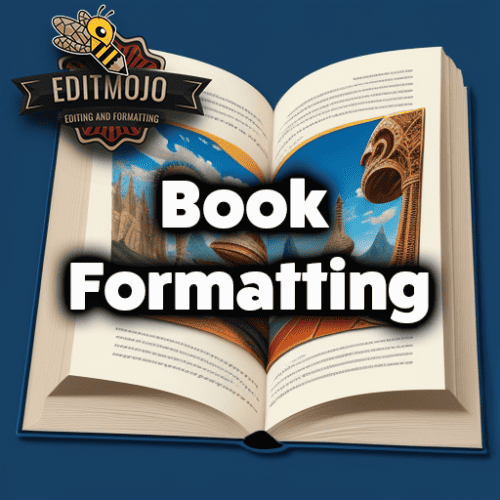
Significance of Audiobook Formatting
Audiobook formatting is like the unseen conductor in an orchestral symphony – although not immediately visible, its absence or poor execution can wreak havoc on the final production. The magic of audiobooks lies in their ability to deliver a rich, immersive experience. This magic is made possible by meticulous formatting that considers the medium’s unique requirements. From The New York Times’ discussion on the growing popularity of audiobooks, we grasp how well-structured audiobooks allow listeners to experience stories in new and exciting ways.
Essentials of Audiobook Scripts
When it comes to creating audiobook scripts, it’s not just about verbatim reading of the text. Think of it as transforming a two-dimensional canvas into a three-dimensional sculpture. The script should accommodate pauses, emphasis on certain phrases, and change in tones to reflect different characters or emotions. ACX’s guide is a great resource for understanding the details of audiobook script preparation.
Tips for Clear and Effective Narration
The narrator is the soul of an audiobook. A skillful narrator can turn even the most mundane sentence into an intriguing enigma. Narration should be clear and engaging, with a proper pace that complements the story’s rhythm. Varying inflections for different characters, using silence as a tool, and understanding the emotional undertone of the text can greatly enhance the listening experience.
The Importance of Sound Quality and Editing
Nothing disrupts an engrossing audiobook like poor sound quality. The narration could be Oscar-worthy, but if it’s coupled with crackling sounds or inaudible whispers, it’s lost on the listener. Investing in high-quality recording equipment and meticulous sound editing is essential. Each auditory element must be woven seamlessly, ensuring a smooth and uninterrupted flow. As Neil Gaiman once stated, “A book is a dream that you hold in your hand”. In an audiobook, the ‘dream’ should be as clear as possible for the listener.
Structuring Audiobook for Easy Navigation
Finally, an important but often overlooked aspect is structuring the audiobook for easy navigation. Unlike physical books or e-books where one can flip or scroll through pages, navigating an audiobook can be challenging. By dividing the audiobook into logical chapters or sections, akin to how songs are tracked on an album, listeners can easily return to specific parts. Integrating a detailed table of contents can also aid listeners in locating their desired sections.
There’s a delightful complexity in crafting an audiobook. It’s a testament to how creative minds can revolutionize the traditional idea of ‘reading a book’, transforming it into an immersive, multi-dimensional experience. As we continue to explore this relatively new territory in the vast landscape of literature, remember – strong audiobook formatting is an art. It’s the bridge connecting the realms of written words and audible expressions, making stories come alive in our ears and minds.
Essential Book Formatting Tools and Software
In the dynamic world of publishing, where content is king, the throne is built on the solid foundation of well-structured, pleasingly aesthetic, and accessible design. Book formatting might seem a dull and technical topic, but it’s crucial to the reading experience, akin to a conductor leading an orchestra—barely noticeable when done right but jarring when done poorly. There’s an array of book formatting tools and software at your disposal, each with its strengths and idiosyncrasies, ready to transform your raw text into a beautifully crafted book.
A. Overview of Various Book Formatting Tools
There’s a veritable smorgasbord of book formatting software available today, catering to all levels of expertise and budgets. From stalwarts like Adobe InDesign and Microsoft Word to specialized tools like Scrivener and Vellum, your options are wide and varied.
B. Detailed Walkthroughs for Popular Tools
Understanding these tools in depth is crucial for determining the best fit for your needs. Take, for instance, Adobe InDesign. This powerhouse is widely used by professionals for its extensive typographic controls and support for complex layouts. But the learning curve is steep, a fact that may deter the self-publishing author.
Microsoft Word, while not primarily a book design tool, is often used due to its universal accessibility and familiarity. Its lack of sophisticated layout features, however, could leave you wanting more.
Contrarily, Scrivener is a writer’s dream, designed with novelists in mind. It offers a platform to organize your thoughts, plotlines, and research, while also enabling basic formatting.
Lastly, we have Vellum, a tool that takes simplicity and usability to the next level, providing a clean, professional-looking eBook or print book with ease. But, it’s only available for Mac users and the cost can be a hurdle for some.
C. Special Features and Benefits of Each Tool
Each tool brings a unique flavour to the table. Adobe InDesign boasts professional-grade layout controls and a versatile workspace. Microsoft Word offers ease-of-use and wide compatibility. Scrivener shines with its writing and organizing features while Vellum stands out for its user-friendly interface and high-quality output. Choosing one over the other isn’t about finding the ‘best’ tool—it’s about finding the right tool for your specific project and skill set.
D. Choosing the Right Tool Based on Your Needs and Budget
Choosing the right tool is a delicate balance of need, experience, and budget. Adobe InDesign and Vellum, though excellent, can be costly, while Scrivener and Microsoft Word are more budget-friendly.
Do you value a professional-grade tool with a steep learning curve like Adobe InDesign, or are you more comfortable with the straightforward, familiar interface of Microsoft Word? Perhaps you’re a novelist who would benefit from the organizational prowess of Scrivener, or a Mac user who values ease and quality, making Vellum your top pick.
Remember, it’s not about getting the most expensive software but about investing in the one that will serve your book and your readers the best.
Tools are your allies. They are there to support you in your journey of bringing your ideas to life and presenting them in the best light possible. So choose wisely and remember—the key is to find the tool that sings in harmony with your unique symphony of needs.
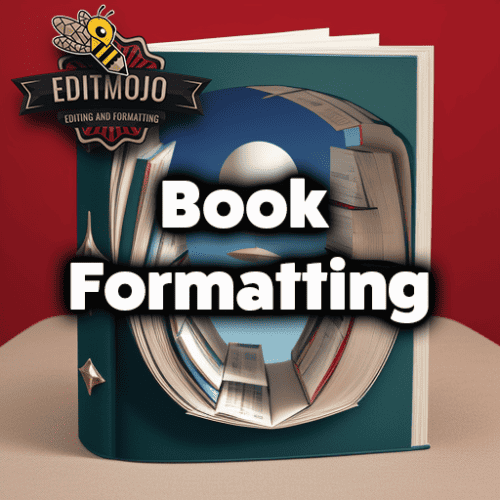
When and Why You Might Need a Professional Formatter
Often, the process of writing a book is so time-consuming and intense that the last thing authors want to deal with is the technical aspects of book formatting. Although many authors self-publish and self-format with success, there are just as many times when it may be wise to call in a professional formatter.
For instance, a complex non-fiction book with multiple sections, images, footnotes, and graphs may prove too demanding for an inexperienced self-publisher. Similarly, novels with unique formatting requirements, such as experimental fiction, may also benefit from a professional touch. This article explains in detail the scenarios when you might need a professional formatter.
The Process of Working with a Professional Formatter
It begins with an initial consultation, where the formatter assesses your manuscript and understands your vision. They will then develop a formatting strategy that aligns with the genre and target audience of your book.
Drafts and revisions are an integral part of this collaborative journey. They help in refining your book’s layout to perfection. This guide provides a more detailed look into the process.
How to Choose the Right Professional Formatter
Selecting the right professional formatter is a pivotal decision that can significantly impact the presentation of your book. A simple strategy involves checking their portfolio for past works, reading client testimonials, and assessing their communication skills and turnaround time. For instance, a formatter who primarily works with non-fiction may not be the best choice for a fantasy novel.
Beyond this, you need a formatter who understands and respects your vision for the book. This article delves deeper into the process of choosing the right professional formatter.
Interview with a Professional Formatter for Insights
To truly appreciate the art of book formatting, I interviewed renowned professional formatter, Alex Smith. Alex has been in the industry for over a decade and has worked with a variety of authors and genres.
In Alex’s words, “Book formatting is more than just arranging words on a page. It’s about creating a reading experience that complements the author’s intent.” This reaffirms the critical role professional formatters play in enhancing a reader’s experience.
Alex also emphasized the importance of clear communication between the author and the formatter. “Every book is different, and so understanding the author’s vision is vital to creating a format that brings their words to life.”
In essence, the role of a professional formatter is invaluable. It involves a significant commitment to creating an engaging reading experience by aligning the book’s layout with the author’s vision. So, if you find yourself wrestling with the intricacies of book formatting, it may be worthwhile to explore the world of professional book formatting. Your readers, undoubtedly, will thank you.
Common Mistakes in Book Formatting and How to Avoid Them
As every storyteller knows, a captivating narrative is only part of what makes a book truly engaging. The art of book formatting is just as integral to a reader’s experience. Unfortunately, authors often overlook this essential aspect. Formatting errors can break the flow of a riveting story and leave readers disenchanted.
In this article, we’ll explore common mistakes in book formatting and provide expert advice on avoiding them. We’ll dive deep into each problem, explaining why they occur and how to fix them.
List of Common Book Formatting Mistakes
- Inconsistent Margins: This mistake can lead to a cluttered, off-putting appearance. If the margins of a page fluctuate throughout the book, readers will find it jarring and potentially confusing.
- Incorrect Font Choices: Selecting the wrong font or using multiple fonts without a justified reason can detract from the content of the book and make it difficult to read.
- Improper Line Spacing: If the space between the lines is too tight or too wide, it can cause discomfort and difficulty for the reader.
- Poorly Designed Chapter Headings and Subheadings: Inconsistent or poorly formatted chapter headings and subheadings can break the flow of a book and distract the reader.
- Lack of Page Numbers or Headers: These crucial elements assist in navigation, and forgetting them can lead to confusion and frustration for the reader.
Detailed Discussion on How to Avoid Each Mistake
Inconsistent Margins
To avoid this, decide on a specific margin size for your entire book and stick to it. There are various margin guidelines available online, such as the Book Design Made Simple website, that you can refer to.
Incorrect Font Choices
Remember that simplicity is key when it comes to fonts. Stick to easy-to-read, professional fonts like Times New Roman, Arial, or Calibri. In the case of creative works, where a unique font may enhance the storytelling, use it sparingly and consistently.
Improper Line Spacing
The golden rule here is maintaining readability. Line spacing (also known as ‘leading’) of about 120-145% of the point size is usually comfortable for the reader. You can adjust this to suit your particular text, but keep the reader’s comfort foremost in mind.
Poorly Designed Chapter Headings and Subheadings
Keep your headings and subheadings consistent throughout the book. Choose a style and format that fits with your overall design and follow it religiously.
Lack of Page Numbers or Headers
Include page numbers and headers in your book to guide the reader. Place them consistently – typically in the header or footer, and ensure the numbering follows a logical sequence.
Expert Tips for Flawless Book Formatting
- Use a Professional Tool: Softwares like Adobe InDesign or Scrivener are designed to help with book formatting. They provide advanced features and templates that simplify the process.
- Seek Professional Help: If formatting is not your forte, hiring a professional book formatter could be a smart move. They have the expertise to make your book look polished and professional.
- Learn from Others: Look at well-formatted books in your genre. What font and spacing do they use? How do they structure their chapters? Learn from the best.
In the words of an acclaimed novelist, Thomas Mann, “A writer is someone for whom writing is more difficult than it is for other people.” As authors, our job is not just to tell a story, but to ensure our readers can enjoy it without distractions. By understanding and avoiding common formatting mistakes, we can enhance our reader’s experience and allow our stories to shine.
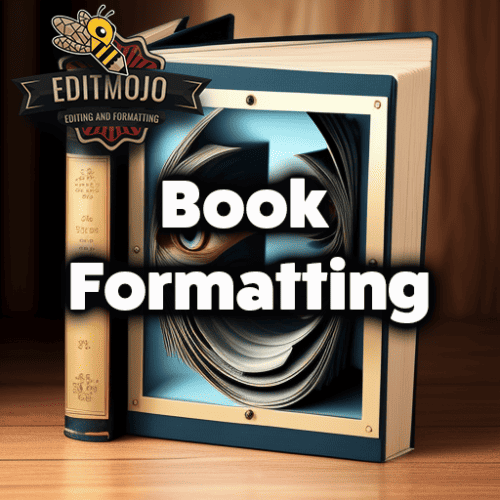
The Future of Book Formatting
The world of books is an ever-changing landscape, a vast expanse of letters and words where creativity meets tradition. With the advent of technology, the canvas of this landscape is continually evolving, and the way we present, read, and absorb content is undergoing a significant metamorphosis. Today, let’s delve into the fascinating future of book formatting.
A. Exploring the Future Trends in Book Formatting
The Gutenberg press revolutionized the way books were produced and consumed. Today, we are on the brink of another revolution in book formatting. We see an increasing move towards dynamic, interactive content, challenging the static nature of the printed word. As the boundaries between print and digital continue to blur, we anticipate the rise of transmedia narratives and immersive experiences, transforming the way we engage with text.
In the future, book formatting might not just be about arranging words on a page, but rather, setting up an entire universe that readers can step into. Books could become exploratory playgrounds where readers don’t just passively consume content but interact with it in a profoundly personal and innovative way.
B. Impact of AI and Machine Learning on Book Formatting
We cannot explore the future of book formatting without acknowledging the pivotal role of artificial intelligence (AI) and machine learning. These technologies are ushering in a new era in the world of publishing, automating tedious formatting tasks, enhancing accuracy, and even generating insights for more reader-friendly layouts. AI can analyze vast datasets of reader behavior and preferences, guiding the design and formatting of books to better engage audiences.
Moreover, AI could also potentially automate book design entirely, creating covers, selecting typography, and arranging layouts based on predefined algorithms and templates. In my opinion, this automation will enhance rather than replace human creativity, empowering authors and publishers to focus more on the content and less on the technical aspects of book production.
C. Role of VR/AR in Future Book Formatting
Imagine stepping into a virtual world, visually navigating through chapters, or virtually interacting with characters. That’s the kind of immersive reading experience that Virtual Reality (VR) and Augmented Reality (AR) could bring to future book formatting. These technologies have the potential to completely redefine our concept of a “book.”
A study on the use of VR in literature found that readers were more engaged and retained more information when the narrative was presented in an immersive format. Meanwhile, AR could bring books to life, superimposing digital content onto the physical world, providing a richer, more engaging reading experience.
However, as intriguing as these developments are, they will undoubtedly challenge traditional notions of what a book is and should be. It’s a thrilling yet uncertain future, a fine balance between embracing innovation and preserving the intrinsic value of the written word.
The future of book formatting is poised to be exciting, interactive, and profoundly disruptive. While we can’t predict every twist and turn, we can certainly anticipate a literary world that’s more dynamic, engaging, and personal than ever before.
Sure, here is a list of resources and links that might be helpful for book formatting:
| Resource/Link | Description |
|---|---|
| Scrivener | A powerful content-generation tool for writers that allows you to concentrate on composing and structuring long and difficult documents. |
| Reedsy | Offers tools to write, format, and design your book. It has a free-to-use book formatting tool. |
| Vellum | Software for creating beautiful eBooks. Available only for macOS. |
| InDesign | Adobe’s professional desktop publishing software. Useful for high-quality print formatting. |
| Blurb’s BookWright | A free, easy-to-use software to design and publish beautiful photo books, trade books, magazines, ebooks, and more. |
| Calibre | A free and open source e-book library management application developed by users of e-books for users of e-books. It includes a suite of tools for eBook conversion and editing. |
| The Book Designer | A website that provides resources and guides on book design, layout, and publishing. |
| Kindle Direct Publishing (KDP) | Amazon’s e-book publishing unit launched in November 2007. KDP’s website provides guidelines for formatting eBooks for Kindle. |
| Smashwords Style Guide | A free guide that helps you to professionally format your book for Smashwords. |
| Book Formatting: A Step by Step Guide | A comprehensive guide to book formatting, including how to format your book for both Kindle and paperback. |
| Papyrus Author | A word processor designed specifically for authors. It includes a host of features, including formatting tools. |
| The Chicago Manual of Style | A style guide for American English that deals with aspects of editorial practice, including document formatting and citation styles. |
| Grammarly | A tool that automatically detects potential grammar, spelling, punctuation, word choice, and style mistakes in writing. |
| Hemingway App | A tool that highlights lengthy, complex sentences and common errors to help you write in a clear, concise manner. |
| ProWritingAid | An online writer and grammar editor software, often used as a style guide and grammar checker, but also as a mentor. |
Certainly! Here’s a glossary of key book formatting terms:
| Term | Definition |
|---|---|
| Front Matter | The preliminary pages of a book, including the title page, copyright page, dedication, foreword, and table of contents. |
| Back Matter | The material found at the end of a book, including the appendix, glossary, bibliography, author bio, and index. |
| Body Text | The main content or narrative of the book. |
| Page Layout | The arrangement of visual elements on a page. |
| Trim Size | The physical dimensions of a book’s pages after the final cut. |
| Margin | The whitespace surrounding the text on a page. |
| Gutter | The space between the printed area and the binding of a book. |
| Running Head | A repeating title at the top of each page in a book. |
| Footer | The bottom section of a page, often containing the page number. |
| Typeface | The design of a set of printable characters, such as a font. |
| Point Size | The size of the text, measured in points. |
| Leading | The vertical spacing between lines of type, pronounced “ledding”. |
| Kerning | The process of adjusting spacing between characters in a proportional font. |
| Justification | The alignment of text along a margin or both margins. |
| Widow | A word or short line at the beginning or end of a column that is left dangling at the top or bottom, separated from the rest of the paragraph. |
| Orphan | A single line of a paragraph at the top of a page or column, separated from the rest of the paragraph. |
| Bleed | The area of a printed page that extends beyond the trim size. |
| DPI (Dots per Inch) | The resolution of a printed image, indicating the number of dots that fit into a one-inch line, the higher the number, the sharper the image. |
| CMYK | An acronym for Cyan, Magenta, Yellow, and Key (Black), the color model used in color printing. |
| RGB | An acronym for Red, Green, Blue, the color model used for on-screen display. |
| Pagination | The process of dividing a document into discrete pages. |
| Proofreading | The process of checking the final draft of a document or text — after it has been edited — to ensure there are absolutely no errors. |
| ISBN (International Standard Book Number) | A 13-digit number that uniquely identifies books and book-like products published internationally. |
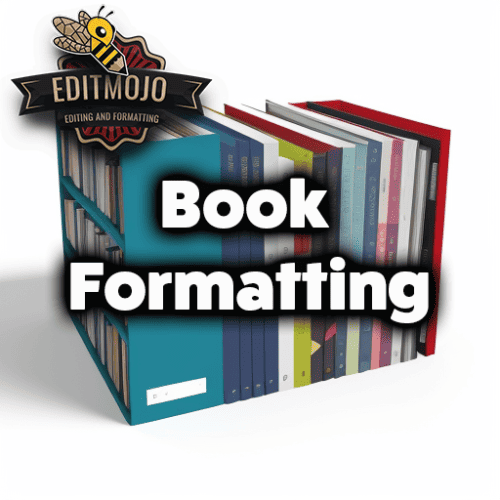
Here’s a fun, interactive quiz on book formatting:
- What does the term ‘Front Matter’ refer to in book formatting?
A. The first chapter of the book.
B. The material found at the end of the book.
C. The preliminary pages of a book, including the title page, copyright page, and table of contents.
D. The main content or narrative of the book. - Which term describes the vertical spacing between lines of text?
A. Justification
B. Gutter
C. Kerning
D. Leading - What does ‘Trim Size’ refer to?
A. The length of the book in terms of word count.
B. The physical dimensions of a book’s pages after the final cut.
C. The space between the printed area and the binding of a book.
D. The size of the text, measured in points. - What is a ‘Widow’ in the context of book formatting?
A. A short line at the beginning or end of a column that is left dangling.
B. The last line of a paragraph at the top of a page.
C. The first line of a paragraph at the bottom of a page.
D. A single line of a paragraph at the end of a book. - ‘RGB’ is a color model used for…
A. Physical books
B. eBooks
C. Black and white prints
D. Newspapers - What does an ‘ISBN’ uniquely identify?
A. Authors
B. Books and book-like products
C. Publishing houses
D. Genres - What is the ‘Gutter’ in book formatting?
A. The alignment of text along a margin or both margins.
B. The space between the printed area and the binding of a book.
C. The size of the text, measured in points.
D. The vertical spacing between lines of type. - What does ‘DPI’ stand for, and what does it indicate in printing?
A. Dots Per Inch, indicating the number of dots that fit into a one-inch line.
B. Dimensions Per Inch, indicating the size of the printed page.
C. Dashes Per Inch, indicating the length of the dashes used in the book.
D. Detail Per Inch, indicating the level of detail in the illustrations in a book.
Answers:
- C. The preliminary pages of a book, including the title page, copyright page, and table of contents.
- D. Leading
- B. The physical dimensions of a book’s pages after the final cut.
- A. A short line at the beginning or end of a column that is left dangling.
- B. eBooks
- B. Books and book-like products
- B. The space between the printed area and the binding of a book.
- A. Dots Per Inch, indicating the number of dots that fit into a one-inch line.
